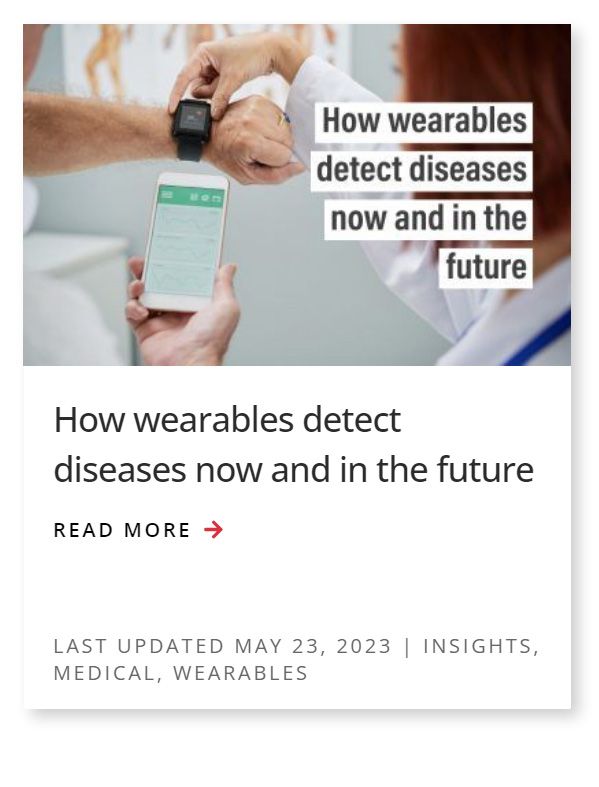We are an award winning product design consultancy, we design connected products and instruments for pioneering technology companies.
5 health tech trends that are gaining momentum
Reading time 9 mins
Key Points
- While digital healthcare technologies such as telemedicine, wearables, health apps, and artificial intelligence get all the attention, lesser-known health tech trends are gaining momentum
- These include technologies such as robotic and cognitive process automation, nanomedicine, and smart implants
- Circular Healthcare – a sustainable approach to tackling the amount of waste generated by the healthcare system – is also receiving considerable attention
- Digital healthcare transformation still has many challenges to overcome. Namely, the amount of energy that cloud storage data management systems require, cyber security and data protection, and ensuring health equity (e.g. algorithm bias in AI contributing to social inequality)
- Despite these considerable challenges, we remain confident that these challenges can be overcome and that digital health tech and tools will be able to live up to their promise.
Looking to revolutionise healthcare experiences with technology? We're here to design health tech solutions that can redefine care provision. Make contact now to find out more.
Ben Mazur
Managing Director
I hope you enjoy reading this post.
If you would like us to develop your next product for you, click here
As we concluded in our last post, the digital health revolution is already here. Technologies such as telemedicine; wearables that help detect diseases; and even artificial intelligence in preventative medicine; if not already in use, are in the pipeline for most healthcare systems and global strategies. In this post, we’ll look at some lesser-known health tech trends that are rapidly gaining momentum, namely:
- Robotic process automation
- Cognitive automation
- Nanomedicine
- Smart implants
- Circularity as part of a climate action strategy
If global digital health activity is anything to go by, health tech tools that improve service delivery, increase efficiency, and reduce costs are receiving considerable interest. As a result, more opportunities for investment and funding for innovation and the development of new technologies are stimulating industry growth, which is estimated to be worth $ 974.5 billion by 2027.
Suggested articles
Emerging technologies in digital healthcare
1. Robotic Process Automation (RPA)
RPA is an automation technology that uses software to mimic back-office tasks of human workers (e.g. billing, inventory, equipment tracking). Error-prone tasks exacerbated by over-burdened and highly stressed hospital staff are reduced – which translates to cost savings, improved efficiencies, and the ability to relocate valuable resources (doctors and nurses) to where they’re needed most (seeing patients).
When it comes to providing patients with improved services, RPA implementation in healthcare can also be used to reduce the time it takes to wait for GP referral appointments, ensure that discharge instructions are followed, and enhance post-treatment care.
2. Cognitive Automation (CA)
CA is the result of combining RPA with artificial intelligence and machine learning (e.g. natural language processing and speech recognition). Whereas RPA is used to unburden the human resources needed for repetitive tasks, the added technologies of AI and machine learning allow healthcare processes to be streamlined and optimised even further due to CA’s ability to gather relevant data, make decisions, and scale automation.
3. Nanomedicine
Nanotechnology refers to the branch of science and engineering devoted to designing, producing, and using structures, devices, and systems by manipulating atoms and molecules at a nanoscale (i.e. 100 millionth of a millimetre). In healthcare, nanomedicine has the potential to enable early prevention and detection; and improve the diagnostics, treatment, and follow-up of many diseases such as cancer, Parkinson’s disease, and Altziemers.
Ways that nanotechnologies are changing healthcare:
- Smart pills, or ‘ingestibles’ that use nanoscale sensors to detect and monitor diseases (e.g. once ingested, nanobots are deployed to a disease site, take pictures, and send them to a doctor or patient).
- It can be leveraged for ultra-precise disease treatment. For example, nanorobots are injected into the bloodstream to seek out and destroy cancer cells while leaving surrounding healthy tissue intact.
- Waterborne diseases are one of the most common causes of illnesses – especially in developing countries where access to clean water is challenging. In many cases, samples of potentially contaminated water need to be sent to a lab – when can take days to process. Nanotech has the possibility to cheaply, quickly, and accurately check for the presence of microbial contaminants in the water supply – thereby reducing illness and death in many regions
- When combined with wearables, this technology is also being used to prevent infection in wounds: smart bandages made from bio-friendly material are applied to the wound and deliver blood-clotting agents and antibiotics that enable faster and safer healing
4. Smart implants
Osteoarthritis, for example, is a degenerative joint disease affecting millions of people worldwide. Other than lifestyle changes (e.g. managing body weight and regular exercise) and medical treatments (e.g. anti-inflammatory and pain medication), chronic cases may require complete joint replacement – which in themselves could result in complications such as wound infection, malfunction of the prosthesis, or infection around the prosthesis.
Smart implants are one of the health tech trends gaining momentum in this field. Using smart technology (e.g. embedded sensors), these implants are designed to integrate with the body and provide real-time data to both the patient and their healthcare provider. They can be used to measure pressure, force, strain, stress, displacement and temperature from inside the body, allowing the health of the implant to be monitored at all times. This, in turn, helps healthcare providers make more informed decisions regarding the care and treatment of their patients before potential problems arise.
5. Circularity as part of a climate action strategy
The healthcare sector is one of the biggest producers of waste, 25% of which is single-use plastics. The NHS is estimated to generate 133,000 tonnes of plastic every year, of which only 5% is recycled. Circular healthcare is a sustainable approach to reducing waste generation by promoting the reuse, repair, and recycling of toxic-free products and materials.
While circularity isn’t a health tech trend in itself, digital health technologies such as big data, AI, blockchain, and the Internet of Things (IoT) have the ability to contribute to positive environmental change:
- They reduce the ‘care miles of patients travelling to and from care facilities
- Reduces the need for single-use personal protective equipment
- Reduction of health sector emissions by moving certain services (e.g. consultations) to the virtual space
- Provide opportunities for health tech startups that tackle medical waste
Speed-bumps on the road to digital healthcare transformation
The circularity in the healthcare trend we mentioned above, in itself, is both a solution and a problem and highlights a major obstacle that trends in health tech will need to overcome. Namely the amount of waste and higher emissions that these technologies generate. As the popularity of cloud computing and offsite storage grows, so too will the amount of energy needed to power these data centres. The growth of AI in digital health poses a similar problem: Multi-billion parameter AI models come with a substantial energy cost and matching carbon footprint.
In addition, there are the challenges of cybersecurity, data privacy, and medical interoperability that we covered in previous posts, and the need for digital health solutions that close the gaps in care and provide health equity for all: The Journal of Medical Internet Research recently published findings that the application of digital health technologies in health care services can, in fact, increase inequalities by influencing the unequal distribution of services. Findings that were corroborated by the Harvard School of Public Health when they examined how algorithmic bias in AI can exacerbate social inequalities in healthcare.
A final word on health tech trends
Although there are big challenges to be overcome, health tech trends such as the automation of repetitive tasks, nanomedicine, and smart medicine, as well as other trends in digital health we covered previously (e.g. telemedicine, wearables, and health apps) are exciting. Especially if they manage to live up to their promise: to help people and those charged with providing care to live longer, happier, and healthier lives!
What are your thoughts on health tech trends? Do you think they’ll be able to live up to their promise? Share your thoughts and let us know!
Comments
Get the print version
Download a PDF version of our article for easier offline reading and sharing with coworkers.






0 Comments